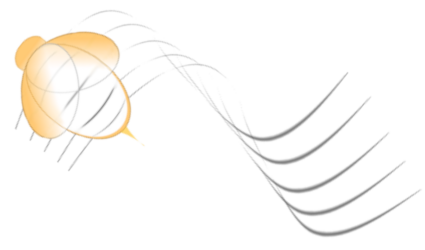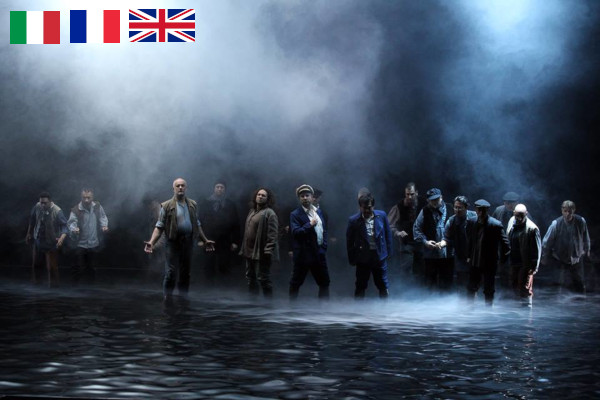Wagner in stivali di gomma
di Suzanne Daumann
Un allestimento originale, e non privo di humor, incornicia, nel vero senso della parola, una bella esecuzione dell'opera di Wagner.
RENNES, 9 maggio 2019 - Per la chiusura di stagione, l’Opéra de Rennes ha ripreso una produzione del teatro di Hagen, in Germania, di Der fliegende Holländer di Richard Wagner. Allestimento firmato da una coppia di sorelle, Beverly e Rebecca Blankenship, questa produzione è assai originale e divertente. La vicenda ruota intorno a un marinaio maledetto, un Olandese condannato a errare sui sette mari finché una donna non gli resterà fedele fino alla morte. Durante una tempesta incontra Daland, capitano di vascello che gli promette sua figlia in cambio delle ricchezze accumulate nel tempo. Senta, la figlia del capitano, per quanto fidanzata con Erik è presa da un innamoramento vago e sognante per uno straniero il cui ritratto si trova nella dimora di suo padre. Costui giunge annunciandole di averle trovato un fidanzato e - stupore! - altri non è che l'uomo del ritratto. Segue una scena d'amore e il lieto fine sembra prossimo. Tuttavia, Erik non vuole lasciare Senta così facilmente e cerca di persuaderla a sposarlo. L'Olandese, da parte sua, ama veramente Senta e vuole rinunciare a lei per proteggerla. Eppure Senta finisce per seguirlo nella morte nella liberazione.
Soggetto romantico, dunque: messa in musica romanticamente da un Wagner ancora giovane, quest'opera supporta una messa in scena un po' originale: la scena è incorniciata come un quadro, la cornice tiene il conto delle sventurate morte per amore dell'Olandese - onta su chi qui pensa a Leporello e al suo catalogo. Abbiamo, dunque, un quadro, ma che è anche una piscina. Infatti, i cantanti si muovono nell'acqua durante tutta l'opera. Ciò offre una nuova dimensione e un mezzo d'espressione drammatica ulteriore: quando qualcuno se ne va, irritato, l'irritazione è ben visibile nell'acqua sotto i suoi piedi… Oltre all'acqua, non serve molto altro per render visibili vascelli, tempeste, terra ferma: cavi per navi e marinai, un argano fatto girare dalle compagne di Senta, invece di filare, fumo illuminato di rosso e blu per onde e tempeste - tanto basta a illustrare la vicenda. Gli eccellenti cantanti e il loro gioco scenico fanno il resto. Il basso-baritono Almas Svilpa, bella voce e presenza scenica impressionante, realizza un vivido Olandese, fra sconforto e tenerezza. Martina Welschenbach è Senta. La sua vocalità sopranile è chiara, ampia, generosa, l'intonazione perfetta: incarna questa donna così forte nella sua convinzione con un abbandono e un'esattezza notevoli. Il Daland di questa produzione ha un piccolo risvolto comico e la voce di basso di Patrick Simper sembra quasi troppo grande per lui. Samuel Sakker è un credibile Erik, Yu Shao intona la canzone del Timoniere proprio con la nostalgia che occorre; e spiace di non ascoltare di più Doris Lamprecht, giacché la parte di Mary è assai piccola.
Rudolf Piehlmayer dirige l’Orchestre Symphonique de Bretagne con spirito ed energia, e i cori, l’Ensemble Vocal Mélisme(s) di Gildas Pungier e il coro d’Angers Nantes Opéra guidato Xavier Ribes, sono sublimi, come sempre.
Una serata romantica, divertente e colorata, dalla quale si esce riflettendo sulla questione dei simbolismi nascosti, di donne che salvano gli uomini, di uomini che salvano le donne, e da cosa esattamente - sempre sentendo risuonare in testa il canto dei marinai. Grazie per questa serata e appuntamento al 13 giugno per la proiezione su grande schermo in Place de la Mairie a Rennes, e su schermi un po' dappertutto in Bretagna!
Wagner en bottes de caoutchouc
par Suzanne Daumann
Une production est fort originale et divertissante encadre une très bonne execution de l'ouvre de Wagner
Rennes, le 9 mai 2019 - Pour son spectacle de fin de saison, l’Opéra de Rennes a repris une production du théâtre de Hagen en Allemagne du Vaisseau Fantôme de Richard Wagner.
Mise en scène par un duo de soeurs, Beverly et Rebecca Blankenship, cette production est fort originale et divertissante.
L’histoire tourne autour d’un marin maudit, un Hollandais qui est condamné d’errer sur les sept mers jusqu’à ce qu’une femme lui reste fidèle jusque dans la mort. Il rencontre dans une tempête Daland, un capitaine de vaisseau qui lui promet sa fille en échange des richesses amassées au fil du temps. Or Senta, la fille du capitaine, bien que fiancée au jeune Erik, est vaguement et rêveusement amoureuse d’un étranger dont le portrait est accroché dans la maison de son père. Celui-ci rentre en lui annonçant lui avoir trouvé un fiancé, et - stupéfaction! - ce n’est nul autre que l’homme du portrait. S’ensuit une scène d’amour et le happy-end semble tout proche. Cependant, Erik ne veut pas lâcher Senta si facilement et tente de la persuader de l’épouser, lui. L’Hollandais de son côté aime réellement Senta et veut renoncer à elle pour la protéger. Senta finit pourtant par lui suivre dans la mort et la libération.
Sujet romantique donc, mis en musique romantiquement par un Wagner encore jeune, cet opéra supporte une mise en scène quelque peu originale: la scène est encadrée comme un tableau, le cadre tient le compte des malheureuses qui ont péri pour l’amour de l’Hollandais - honni soit qui pense à Leporello et son catalogue ici. La scène est donc un tableau, et en même temps une piscine. En effet et tout à fait, les chanteurs pataugent dans l’eau tout au long de la pièce. Cela donne une dimension nouvelle et un moyen d’expression dramatique supplémentaire: quand quelqu’un s’en va, vexé, son agacement sera bien visible dans l’eau qui jaillit sous ses pieds… En plus de l’eau, il ne faut pas grand-chose pour rendre visible vaisseaux, tempêtes, et la terre ferme: des câbles pour vaisseaux et matelots, un cabestan que tournent les camarades de Senta, au lieu de filer la laine, de la fumée illuminée en rouge et bleue pour tempêtes et vagues - cela suffit pour illustrer l’histoire. Les excellents chanteurs et leur jeu de scène font le reste. Le baryton-basse Almas Svilpa, belle voix chaude et présence scénique impressionnante, campe un Hollandais très vivant, entre désespoir et tendresse. Martina Welschenbach est Senta. Sa voix de soprano est claire, ample, généreuse, l’intonation parfaite; elle incarne cette femme si forte dans sa conviction avec un abandon et une justesse remarquables. Le Daland de cette production a un petit côté bouffon, et la voix de basse de Patrick Simper semble presque trop grande pour lui. Samuel Sakker est crédible comme Erik, Yu Shao chante la chanson du pilote avec juste ce qu’il faut de nostalgie; et on regrette de ne pas entendre plus souvent la voix de Doris Lamprecht, puisque le rôle de Marie est assez petit. Rudolf Piehlmayer dirige l’Orchestre Symphonique de Bretagne avec énergie et humour, et les choeurs, l’Ensemble Vocal Mélisme(s) dirigé par Gildas Pungier et le choeur d’Angers Nantes Opéra sous Xavier Ribes sont sublimes, comme toujours.
Une soirée romantique donc, divertissante et colorée, dont on sort en réfléchissant à la question du symbolisme derrière tout cela, des femmes sauvent des hommes, des hommes sauvent des femmes, et de quoi au juste - tout en entendant le chant des marins résonner dans la tête…
Merci pour cette soirée - rendez-vous le 13 juin pour la transmission sur grand écran Place de la Mairie à Rennes, et sur écrans un peu partout en Bretagne!
Wagner in Wellingtons
by Suzanne Daumann
A production unique and diverting frames like a painting a good version of Wagner's opera.
Rennes, on May 9, 2019 - For their last show of the season the Rennes Opera has taken up a production from Hagen, Germany, of Richard Wagner’s Flying Dutchman. Staged by a duo of sisters, Beverly and Rebecca Blankenship, it is quite unique and diverting.
The storyline revolves around a captain and a curse, the Dutchman is condemned to sail the seven seas until a woman’s faithfulness relieves him. During a storm, he meets his colleague, Captain Daland, who promises his daughter to him, in exchange for the riches he has amassed over the centuries. The captain’s daughter, Senta, his engaged to Erik, but she’s also vaguely and dreamily in love with a stranger whose portrait hangs on a wall in her home. Her father comes home and announces having found her a husband, and - lo and behold! - it’s none other but the man on the portrait. They fall instantly for each other and the happy ending seems imminent. The Dutchman however doesn’t want Senta do share his fate and decides to leave on the next storm. She throws herself into the sea after him, and they are both saved - dead but on their way to heaven, one must assume.
A most romantic story and set to music most romantically by a young Wagner, this opera can handle a somewhat original staging: the stage is framed like a painting and the frame shows the count of the Dutchman’s victims, women that perished for his love and their own infidelity - honni soit who thinks of Leporello here and his catalogue. The stage is a painting, and a pool. Indeed, the singers have to splash through knee-deep water all along the piece. Uncomfortable as it might look, the water does give them a supplementary medium of expression: sending up fountains of water certainly increases the drama of say, someone walking angrily away. It doesn’t take much more to make visible ships, storms and safe ground: ropes for ships and sailors, a capstan that Senta’s friends turn instead of spinning wool, red and blue lit smoke for storms and high seas. The excellent singers and their great stage play do the rest. Bass-baritone Almas Svilpa, with a beautiful warm voice and impressive stage presence is a very credible Dutchman, between despair and tenderness. Martina Welschenbach, soprano, is Senta. Her voice is clear, large, generous, the intonation perfect; she plays this strong woman with remarkable abandon. The Daland of this production is a bit of a buffoon, and Patrick Simper does him justice, his amazing bass voice almost too big for the part. Samuel Sakker is a creditable Erik, Yu Shao sings the helmsman’s song with the right dose of nostalgia. A pity that Marie doesn’t have more to say, we’d have loved to hear more of Doris Lamprecht’s lovely voice. Rudolph Piehlmayer conducts the Orchestre Symphonique de Bretagne with energy and humour, and the choirs, Gildas Pungier’s Ensemble Vocal Mélisme(s) and the Choir of Angers Nantes Opéra under Xavier Ribes are sublime, as always.
A romantic evening, amazing and amusing, that we leave thinking about the symbolism of all this, women saving men, men saving women, water, ships and the seven seas, and with the sailors’ chorus humming in our brains.
Thank you, Opéra de Rennes!
NB: On June 13, the show will be broadcast on a giant screen, on Place de la Mairie, Rennes, and in many other places in Brittany.
















